RIVERDANCE 10 YEARS ON: Dismantlers, gawkers and plunderers are next to come
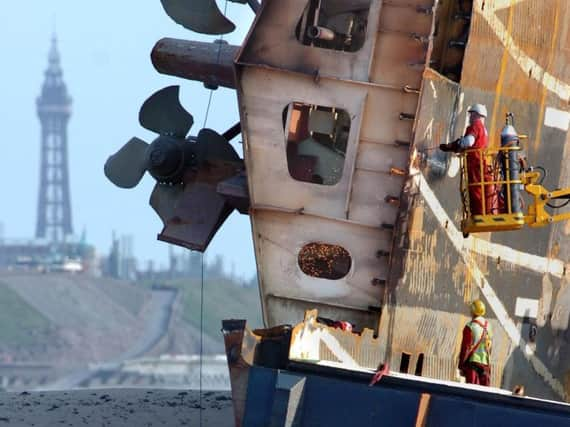

Coastguard volunteers and officers from across the Fylde coast, still exhausted from playing their part in the dramatic rescue of 23 crew and passengers just hours earlier, were tasked with keeping the crowds away from the vessel.
Whenever the tide was out, they’d be there, stood in the cold, chasing away the daring and guarding against the opportunist thieves seeking a quick buck.
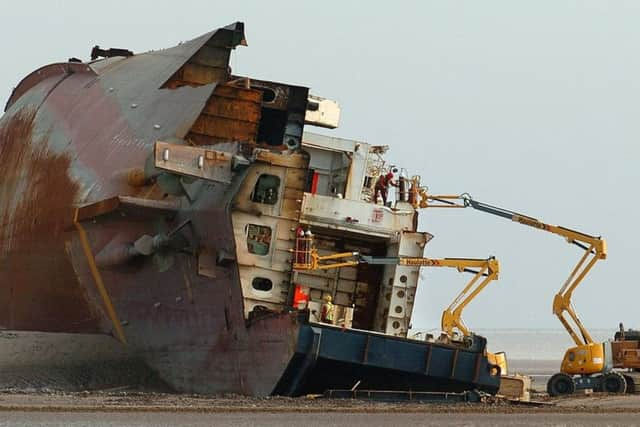

Advertisement
Hide AdAdvertisement
Hide AdMostly, it was boring, enough to make one time-served rescuer to consider throwing in the towel – ‘This wasn’t what I had signed up for’, he was left thinking.
But once, officials stood bemused as three men climbed out of a hired Ford Transit van and began to move cones in an attempt to drive onto the beach.
After being challenged, one of them, speaking in a broad Liverpool accent, said they were there for the whisky they had been told about.
There was timber. Plenty of scrap metal too. And plastic glasses, peat, biscuits, and bags of out-of-date paracetamol being shipped back for disposal.
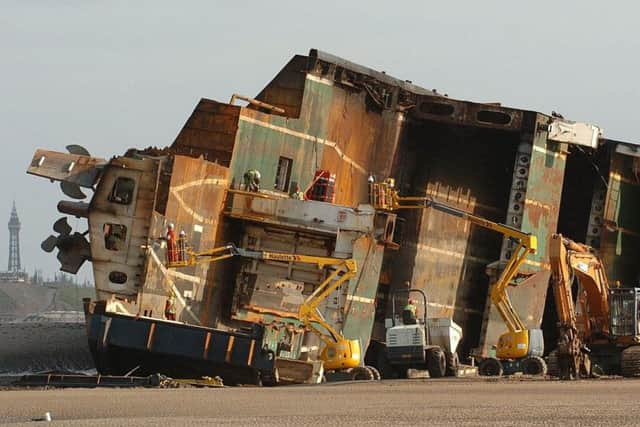

Advertisement
Hide AdAdvertisement
Hide AdBut no bottles of single malt – leaving the trio of chancers bemoaning their rotten luck as they drove away with their wallets one Transit van rental lighter.
On another occasion, in fact on several, volunteers had to collar an impudent photographer who tried his hardest to sneak past the cordon for take some close-up snaps.
Each time he was sent packing, camera and tripod and all, only to try again later in a different guise.
Two men in full climbing gear were also tackled.
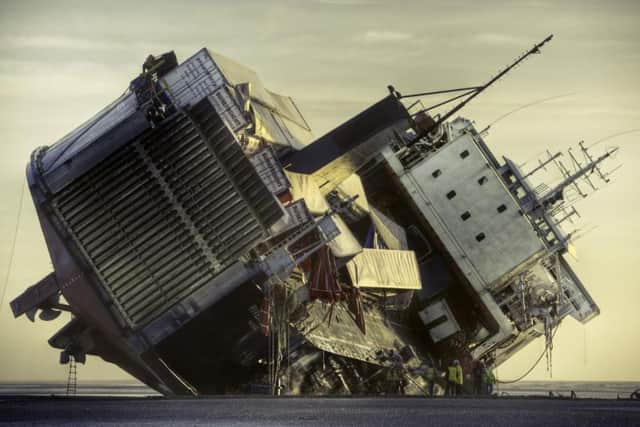

And it wasn’t just people on foot. Several jet skierss got too close, with one being followed and given a slap on the wrist and ordered to keep his distance.
Advertisement
Hide AdAdvertisement
Hide Ad“We were there 24 hours a day until the Sunday evening when the Coastguard was stood down,” Mark Sumner, the station officer at Fleetwood Coastguard, said.
They were promptly sent back after photographs, brought to the attention of senior officials, showed mums with prams standing beneath the steel titan’s stern.
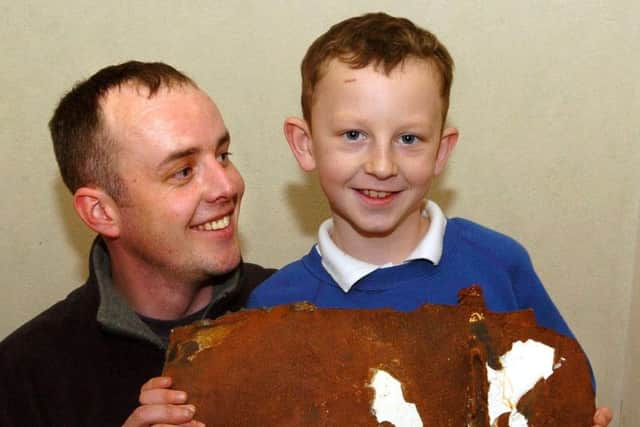

Dozens of people got close enough to touch the 6,000-tonne ship, which was tilted at an angle of 80 degrees and in danger of toppling over and crushing them.
Many even made it over to the port side, directly under trucks left hanging precariously over the railings, while some even had to be stopped from climbing aboard.
Advertisement
Hide AdAdvertisement
Hide Ad“They risked their lives,” Insp Tim Newton, who led the police operation, said at the time. “Anything could have fallen off the ship.”
And Mr Sumner added: “Not only was it accessible by foot, but people thought it was rich pickings.”
And there they remained for seven weeks, waving the Merchant Shipping Act 1995 at those who demanded to know what law allowed the 400m exclusion zone to be set up, until a private security firm was put in place.
Nobody was prosecuted for getting too close, while looters were mainly kept at bay, though police were called in after a life-jacket plucked from the Riverdance was posted for a macabre auction on eBay.


Advertisement
Hide AdAdvertisement
Hide AdIn the weeks that followed the ship’s stranding, hundreds of tonnes of oil and diesel was drained, with salvors from Dutch firm Smit International planning to move water from one side to the other to try and stand it up.
Vents were sealed by welding metal plates over them, pumping gear was rigged, and four huge tanks, each weighing 20 tonnes, were attached to the port side of the ship.
A giant trench was dug in the sand for the Riverdance to settle into, with tugs expected to guide the vessel out to sea.
“The list will be reduced by pumping water from the ballast tanks on the starboard side to the port side, which is currently face up,” Tony Redding from owner Seatrucks said at the time.
But the Riverdance would never sail again.
Advertisement
Hide AdAdvertisement
Hide AdDeclared a ‘constructive loss’ after bad weather and shifting sands left it sinking deeper and deeper, almost bottom up and completely submerged at high tide, contractors planned to winch the ship before taking it on a final voyage to the scrapyard.
The final death knell sounded for the doomed ferry in early April, when it was finally confirmed it would be cut up on the beach.
Jim Hancock and his team from Lancaster were brought in, and studied the Riverdance’s sister ship, the Moondance, to come up with a plan.
Speaking after returning to the resort to speak to The Gazette, Jim said: “One of the biggest challenges, when we first got on there, was getting the oil off.
Advertisement
Hide AdAdvertisement
Hide Ad“We got designs and drawings of the boat and they were as big as my car. We had to have engineers to help us read them; we’re just demolition boys.
“There was supposed to be 150 tonnes of oil on there, and 300 tonnes later it was still coming off.
“The boat was lying on its side, and as the tide lifted it up and fetched it down, the boat was weakening.
“So the fear was the boat would crack, and if the boat cracked and the oil was on it...
“Nothing was damaged though. We did well.”
Advertisement
Hide AdAdvertisement
Hide AdHe continued: “The boat was breaking. You could hear it groaning. Every day, [the site manager] John Horner stood at a certain post and took a picture of the boat at an angle. You could see it every day changing shape at the start.
“You could see it bending. As it was cracking, Smit Salvage were doing emergency repair work but it was all in vain.”
The recycling operation was expected to take 14 weeks, with the first four of five weeks spent gutting the ship, with 50 men sleeping in cabins on the Promenade.
Cargo - mostly wood, insulation, and scrap metal - was removed, as were any unnecessary parts, to reduce weight, stabilise the Riverdance, and make room.
Advertisement
Hide AdAdvertisement
Hide AdThe upper decks were then dismantled, with the hull the final section to be cut up, with each piece being removed from the beach by massive cranes.
During each stage of the process, anti-pollution measures were put in place to make sure there was no threat to life.
With the water lapping against the wreckage, crews had to work when the tide was out, including at night. It was also done slower than expected, after fuel was found to remain on board, and because of wind and rain.
Shortly before dawn on Saturday, May 17, 12 workers were evacuated after two tractor units burst into flames in the cargo hold, triggered by sparks showering down from cutting kit.
Advertisement
Hide AdAdvertisement
Hide AdFire crews were called out, but eventually withdrew to the safety of the prom to allow the rising tide to put the blaze out.
Firefighters later returned and, following an inspection, work continued and, by July, the ship’s heart, one of its huge 40 tonne engines, was removed and taken to a spares company in the north east.
The steel piece of the bow containing the ship’s name was kept by contractors as a memento of the operation, while the rest went to scrapyards, the main one being in Liverpool.
And by mid-October, salvors were in the final stages of removing the stricken ship.
Advertisement
Hide AdAdvertisement
Hide AdSonar was used to check beneath the sand for any left-over metal, sparking unfounded rumours valuable cargo was lying around.
Mr Horner – who Jim said has since died – said a woman, with two children in a pram, crossed the beach at 11pm, in the ‘pitch black’.
He said: “She was looking for whisky.”
A month later, the last pieces of Riverdance had been recovered from the sand, and the exclusion zone was lifted.
The government’s man in charge of the clear-up, Hugh Shaw, told The Gazette: “As far as we’re concerned the beach has now been cleared.”
Advertisement
Hide AdAdvertisement
Hide AdJim added: “It took an awful lot longer, but we had to do what we had to do. We had undertaken the challenge and we didn’t get paid for the job until we completed it.
“No-one had done a job like this, so it was a case of ‘suck it and see’. We got it done in the end, by hook or crook.”
Blackpool Council’s deputy leader at the time, Coun Ian Fowler, also said at the time: “The whole episode has gone extremely well.
“Although some local residents think it has taken a long time, that is because of the ecological care that was taken to ensure no oil spilled onto the beach.”
Advertisement
Hide AdAdvertisement
Hide AdThe environmental damage caused by fuel and oil leaking from the Riverdance could have been catastrophic for marine life.
But contractors were praised for their efforts in keeping the beach oil and diesel free during the tricky operation, with fears of any spill going unrealised.
Michael Meekums from the Marine and Fisheries Agency said he was ‘very happy’ after no leaks were reported, while the Secretary of State’s Representative Huge Shaw - the man in overall charge of the ship’s removal - said he was ‘delighted’.
And Alan Wright, from the North West Wildlife Trust, said had the 150 tonnes of fuel and oil spilled, it would have been ‘an environmental disaster for the coast’.
Advertisement
Hide AdAdvertisement
Hide AdHe added: “People using the beach would have found it nasty, sticky, and horrible. Sea birds would have suffered and we would have ended up with dead fish and other marine life as well.
“There would have been a major clean up operation.”
In recent years, the number of royal mammals - porpoises, whales, and bottlenose dolphins - washing ashore has risen, while basking sharks and humpback whales have been spotted swimming off the coast.
In 2016, a green turtle, usually only found in the Caribbean, was recorded by wildlife experts, while pods of dolphins are now routinely caught on tape by amazed holidaymakers.
Rescuers from the RNLI were even forced to scramble in their lifeboats last year after passers-by tried to rescue a drowning dog - that turned out to be a bewildered seal.
Advertisement
Hide AdAdvertisement
Hide AdAnd Mr Wright said any spill ‘could have set us back a long time in terms of the great work that has been done as far as making the Irish Sea a nice place for wildlife life’.
He added: “It would have been a long-term thing, and there would still be signs of it today.”
One final twist in the Riverdance saga was drainage to a vital drainage pipe, which was crushed after the ship came to a halt on top of it.
It emerged from the seabed in late 2009, with an oil-rig structure called a cofferdam put up to help with replacement work.
Advertisement
Hide AdAdvertisement
Hide AdIt was designed to prevent any of the pipe’s contents spilling, and was quickly dubbed ‘son of Riverdance’.
The cost of replacing the 18.5m section, with work being done by divers, was estimated at up to £2 million.
